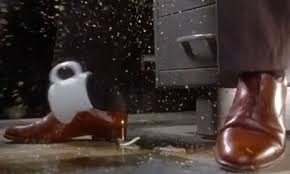Chapter
1: Photography; Blog Post #6
Caroline Stanish
Film Lit, Period 3
In the three films “The Usual Suspects,”
“Gladiators” and “Eternal Sunshine of the Spotless Mind,” a character is driven
by an overwhelming motive of self-preservation to do something that would be
considered immoral by the society or group in which the character lives.
In the movie “The Usual Suspects,” the character
Verbal Kint is an accomplished con man who creates an elaborate tangle of lies
to avoid detection by the police. Through the oblique camera angles and low
lighting in the opening scene, the filmmaker sets up the con to demonstrate how
far Verbal will go to protect himself.
Then in the realization sequence near the end, the
filmmaker uses cinematographic effects (including slow-motion) and editing to reveal its secret
without the audience feeling let down by a trick.1 In a sense the filmmaker demonstrated
great skill at contributing to Verbal’s con by letting the audience believe
that his character was a victim.

In “Eternal Sunshine of the Spotless Mind,” the
character Dr. Howard convinced his assistant Mary to have her memories of him
erased because he had had an affair with her and justified that to himself
because he didn’t want to get caught by his wife. In the scene in Joel’s
apartment Dr.Howard realizes that Mary is beginning to develop feelings for him
again, even though he had her memories erased of him before. The repeated close
up shots of his face, use of cool colors and the subdued lighting in the room
worked together to show a sense of his dread that his previous problem is
coming back. The look of this scene
represents a documentary lighting style which makes it seem more realistic. The
filmmaker used very different looks in other parts of the movie to convey the
full effect of memories. According to writer John Pavlus, “With its slippery
shifts between reality and distorted memories, Eternal Sunshine required a look
that could blend location-shoot authenticity with unpredictable flashes of
whimsy.” 2

In “Gladiator,” Maximus (the Spaniard) convinced all
the gladiators to stand together in the games, which was against the way the
king wanted the battles to take place. Maximus banded all the gladiators
together for self preservation so he could still be alive to take revenge on
the king who had ordered his family killed. The filmmaker chose high contrast
lighting and positioning of the gladiators in a tight grouping to show the
power of the gladiators sticking together. The light accentuates the muscles of
the gladiators, showing the strength they have in numbers. According to a
similar analysis by Deborah Tudor, “When Maximus enters the arena, the framing shifts to a heroic low
angle….the light falls from the upper-left, creating a halo on his bare sword
arm, guiding the eye to, and emphasizing, his biceps. The acute low angle picks
out the abdominal muscles sculpted on his torso armor.”3 By emphasizing the strength of the
gladiators, the filmmaker conveyed the determination behind Maximus’ choice.

The characters of Verbal Kint, Dr. Howard and
Maximus shared a common quandary. All were faced with a major problem that they
had to resolve or it would lead to their downfall. All three chose a solution
of self-preservation that meant doing something that was considered immoral or
wrong in their society. In each of these films, directors chose clever
techniques to convey specific aspects of the characters’ situations.
References
1.
“Sound Lies -
Achieving Closure in The Usual Suspects,” David Mitchell, Autumn 2000, online
blog http://www.zenoshrdlu.com/zenosusp.htm, accessed September 28, 2014.
2.
“Forget Me Not,”
John Pavlus, American Cinematographer,
April 2004, online http://www.theasc.com/magazine/april04/cover/, accessed September 28, 2014.
3.
“Nation, Family
and Violence in ‘The Gladiator’,” Deborah Tudor. Jump Cut, A Review of Contemporary Media, 2002, http://ejumpcut.org/archive/jc45.2002/tudor/index.html, accessed September 28, 2014.










